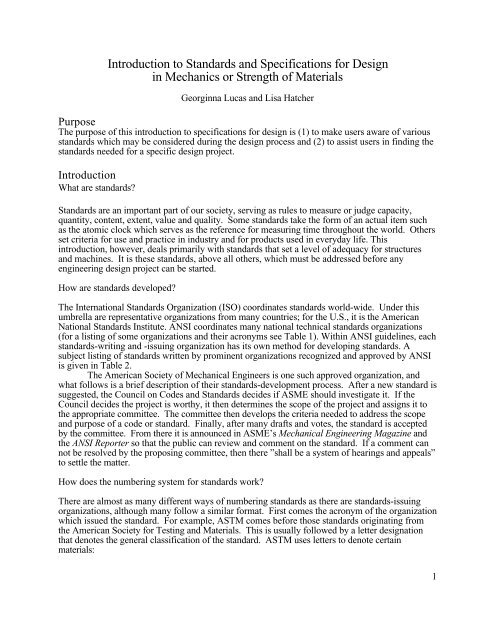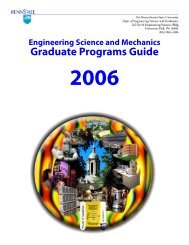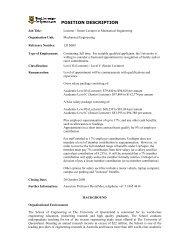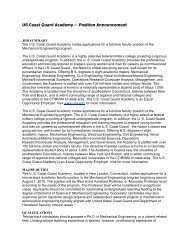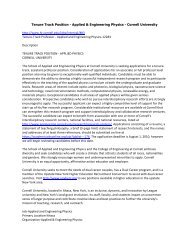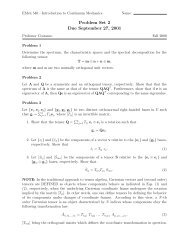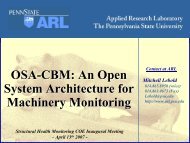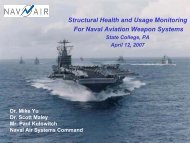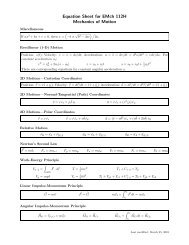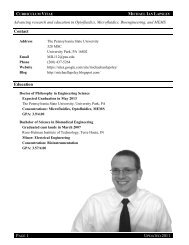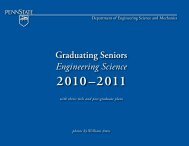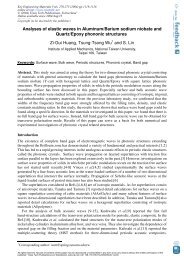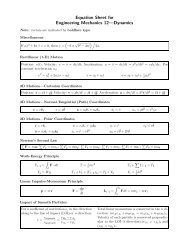Introduction to Standards and Specifications for Design in ...
Introduction to Standards and Specifications for Design in ...
Introduction to Standards and Specifications for Design in ...
Create successful ePaper yourself
Turn your PDF publications into a flip-book with our unique Google optimized e-Paper software.
<strong>Introduction</strong> <strong>to</strong> <strong>St<strong>and</strong>ards</strong> <strong>and</strong> <strong>Specifications</strong> <strong>for</strong> <strong>Design</strong><br />
<strong>in</strong> Mechanics or Strength of Materials<br />
Georg<strong>in</strong>na Lucas <strong>and</strong> Lisa Hatcher<br />
Purpose<br />
The purpose of this <strong>in</strong>troduction <strong>to</strong> specifications <strong>for</strong> design is (1) <strong>to</strong> make users aware of various<br />
st<strong>and</strong>ards which may be considered dur<strong>in</strong>g the design process <strong>and</strong> (2) <strong>to</strong> assist users <strong>in</strong> f<strong>in</strong>d<strong>in</strong>g the<br />
st<strong>and</strong>ards needed <strong>for</strong> a specific design project.<br />
<strong>Introduction</strong><br />
What are st<strong>and</strong>ards?<br />
<strong>St<strong>and</strong>ards</strong> are an important part of our society, serv<strong>in</strong>g as rules <strong>to</strong> measure or judge capacity,<br />
quantity, content, extent, value <strong>and</strong> quality. Some st<strong>and</strong>ards take the <strong>for</strong>m of an actual item such<br />
as the a<strong>to</strong>mic clock which serves as the reference <strong>for</strong> measur<strong>in</strong>g time throughout the world. Others<br />
set criteria <strong>for</strong> use <strong>and</strong> practice <strong>in</strong> <strong>in</strong>dustry <strong>and</strong> <strong>for</strong> products used <strong>in</strong> everyday life. This<br />
<strong>in</strong>troduction, however, deals primarily with st<strong>and</strong>ards that set a level of adequacy <strong>for</strong> structures<br />
<strong>and</strong> mach<strong>in</strong>es. It is these st<strong>and</strong>ards, above all others, which must be addressed be<strong>for</strong>e any<br />
eng<strong>in</strong>eer<strong>in</strong>g design project can be started.<br />
How are st<strong>and</strong>ards developed?<br />
The International <strong>St<strong>and</strong>ards</strong> Organization (ISO) coord<strong>in</strong>ates st<strong>and</strong>ards world-wide. Under this<br />
umbrella are representative organizations from many countries; <strong>for</strong> the U.S., it is the American<br />
National <strong>St<strong>and</strong>ards</strong> Institute. ANSI coord<strong>in</strong>ates many national technical st<strong>and</strong>ards organizations<br />
(<strong>for</strong> a list<strong>in</strong>g of some organizations <strong>and</strong> their acronyms see Table 1). With<strong>in</strong> ANSI guidel<strong>in</strong>es, each<br />
st<strong>and</strong>ards-writ<strong>in</strong>g <strong>and</strong> -issu<strong>in</strong>g organization has its own method <strong>for</strong> develop<strong>in</strong>g st<strong>and</strong>ards. A<br />
subject list<strong>in</strong>g of st<strong>and</strong>ards written by prom<strong>in</strong>ent organizations recognized <strong>and</strong> approved by ANSI<br />
is given <strong>in</strong> Table 2.<br />
The American Society of Mechanical Eng<strong>in</strong>eers is one such approved organization, <strong>and</strong><br />
what follows is a brief description of their st<strong>and</strong>ards-development process. After a new st<strong>and</strong>ard is<br />
suggested, the Council on Codes <strong>and</strong> <strong>St<strong>and</strong>ards</strong> decides if ASME should <strong>in</strong>vestigate it. If the<br />
Council decides the project is worthy, it then determ<strong>in</strong>es the scope of the project <strong>and</strong> assigns it <strong>to</strong><br />
the appropriate committee. The committee then develops the criteria needed <strong>to</strong> address the scope<br />
<strong>and</strong> purpose of a code or st<strong>and</strong>ard. F<strong>in</strong>ally, after many drafts <strong>and</strong> votes, the st<strong>and</strong>ard is accepted<br />
by the committee. From there it is announced <strong>in</strong> ASME’s Mechanical Eng<strong>in</strong>eer<strong>in</strong>g Magaz<strong>in</strong>e <strong>and</strong><br />
the ANSI Reporter so that the public can review <strong>and</strong> comment on the st<strong>and</strong>ard. If a comment can<br />
not be resolved by the propos<strong>in</strong>g committee, then there ”shall be a system of hear<strong>in</strong>gs <strong>and</strong> appeals”<br />
<strong>to</strong> settle the matter.<br />
How does the number<strong>in</strong>g system <strong>for</strong> st<strong>and</strong>ards work?<br />
There are almost as many different ways of number<strong>in</strong>g st<strong>and</strong>ards as there are st<strong>and</strong>ards-issu<strong>in</strong>g<br />
organizations, although many follow a similar <strong>for</strong>mat. First comes the acronym of the organization<br />
which issued the st<strong>and</strong>ard. For example, ASTM comes be<strong>for</strong>e those st<strong>and</strong>ards orig<strong>in</strong>at<strong>in</strong>g from<br />
the American Society <strong>for</strong> Test<strong>in</strong>g <strong>and</strong> Materials. This is usually followed by a letter designation<br />
that denotes the general classification of the st<strong>and</strong>ard. ASTM uses letters <strong>to</strong> denote certa<strong>in</strong><br />
materials:<br />
1
• A -- ferrous metals <strong>and</strong> products<br />
• B -- nonferrous metals <strong>and</strong> products<br />
• C -- cementitious, ceramic, concrete <strong>and</strong> masonry materials<br />
• D -- miscellaneous materials <strong>and</strong> products<br />
• E -- miscellaneous subjects<br />
• F -- end-use materials <strong>and</strong> products<br />
• AG -- corrosion, deterioration, weather<strong>in</strong>g, durability <strong>and</strong> degradation of materials <strong>and</strong><br />
products<br />
• ES -- emergency st<strong>and</strong>ards.<br />
A sequential number follows the letter. If the st<strong>and</strong>ard is written us<strong>in</strong>g metric units but has a<br />
companion st<strong>and</strong>ard <strong>in</strong> <strong>in</strong>ch-pound units (or any other type of units), it is then followed by an M <strong>to</strong><br />
identify the metric st<strong>and</strong>ard. Next, usually follow<strong>in</strong>g a hyphen, is either the full year <strong>in</strong> which the<br />
st<strong>and</strong>ard was issued or else the last two numbers of that year (89 <strong>for</strong> 1989). Some organizations<br />
will change this number <strong>to</strong> <strong>in</strong>dicate the year <strong>in</strong> which the st<strong>and</strong>ard was last revised; others place this<br />
<strong>in</strong><strong>for</strong>mation <strong>in</strong> parenthesis after the title of the st<strong>and</strong>ard. Should the year be followed by a lower<br />
case letter, it <strong>in</strong>dicates that there was more than one revision of the st<strong>and</strong>ard dur<strong>in</strong>g that year ("a"<br />
<strong>in</strong>dicates the second revision, "b" <strong>in</strong>dicates the third, etc.).<br />
An example of an ASTM st<strong>and</strong>ard is st<strong>and</strong>ard ASTM F468M-93: Nonferrous Bolts, Hex<br />
Cap Screws <strong>and</strong> Studs <strong>for</strong> General Use (Metric). As you can see, us<strong>in</strong>g the <strong>in</strong><strong>for</strong>mation <strong>in</strong> the<br />
previous paragraph, the number itself provides an enormous amount of <strong>in</strong><strong>for</strong>mation. We know<br />
just by look<strong>in</strong>g at it that the st<strong>and</strong>ard <strong>to</strong> which it refers is issued by the American Society <strong>for</strong><br />
Test<strong>in</strong>g <strong>and</strong> Materials, that it deals with an end-use material or product, <strong>and</strong> that it is written us<strong>in</strong>g<br />
metric units.<br />
Indexes of <strong>St<strong>and</strong>ards</strong>:<br />
There are many sources available <strong>to</strong> locate the necessary st<strong>and</strong>ards <strong>for</strong> any design project. While<br />
they do not hold <strong>in</strong>-depth <strong>in</strong><strong>for</strong>mation on <strong>in</strong>dividual st<strong>and</strong>ards, they do provide <strong>in</strong><strong>for</strong>mation<br />
relevant <strong>to</strong> many <strong>to</strong>pics. Some of the <strong>in</strong><strong>for</strong>mation available <strong>in</strong> these references <strong>in</strong>cludes lists of<br />
st<strong>and</strong>ards-related organizations, cumulative subject <strong>in</strong>dexes of st<strong>and</strong>ards (giv<strong>in</strong>g related<br />
organizations, the st<strong>and</strong>ards themselves, or st<strong>and</strong>ards-related periodicals), <strong>and</strong> numeric lists of<br />
st<strong>and</strong>ards.<br />
Also available are searchable <strong>in</strong>dexes that can be found on many st<strong>and</strong>ards-issu<strong>in</strong>g<br />
organizations’ web pages. They allow users <strong>to</strong> search by keywords <strong>in</strong> the st<strong>and</strong>ard or by its<br />
number. While these pages do not allow access <strong>to</strong> the details conta<strong>in</strong>ed <strong>in</strong> the st<strong>and</strong>ards, they do<br />
give the number <strong>and</strong> title of the st<strong>and</strong>ard. In some cases they contribute a brief description of the<br />
type of <strong>in</strong><strong>for</strong>mation <strong>in</strong>cluded. See Table 2 <strong>for</strong> web sites.<br />
<strong>St<strong>and</strong>ards</strong> covered here:<br />
There are an <strong>in</strong>credible number of st<strong>and</strong>ards-issu<strong>in</strong>g organizations throughout the world. In this<br />
<strong>in</strong>troduction we summarize several of those which issue st<strong>and</strong>ards pert<strong>in</strong>ent <strong>to</strong> design <strong>in</strong> Mechanics<br />
of Materials. They are arranged <strong>in</strong> alphabetical order by the organization’s name. Topics range<br />
from materials used <strong>in</strong> design <strong>to</strong> ergonomics.<br />
2
Aerospace Industries Association of America, Inc.<br />
http://www.access.digex.net/~aia/<br />
AIA represents America’s lead<strong>in</strong>g manufacturers of commercial, military, <strong>and</strong> bus<strong>in</strong>ess aircraft,<br />
helicopters, aircraft eng<strong>in</strong>es, missiles, spacecraft, <strong>and</strong> related components <strong>and</strong> equipment. AIA<br />
provides many of the country’s national aerospace st<strong>and</strong>ards, which cover such <strong>to</strong>pics as screws,<br />
bolts, nuts <strong>and</strong> washers; wires; tube assembly; tw<strong>in</strong> seaplane floats; shackle components <strong>for</strong><br />
ground support equipment; angles; tees <strong>and</strong> brackets.<br />
The Alum<strong>in</strong>um Association, Inc.<br />
http://www.alum<strong>in</strong>um.org/<br />
AAI is the trade association <strong>for</strong> U.S. producers of alum<strong>in</strong>um <strong>and</strong> semi-fabricated alum<strong>in</strong>um<br />
products as well as alum<strong>in</strong>um recyclers. AAI provides leadership <strong>to</strong> the <strong>in</strong>dustry through its<br />
programs <strong>and</strong> services which aim <strong>to</strong> <strong>in</strong>crease the use of alum<strong>in</strong>um, remove impediments <strong>to</strong> its<br />
advancement <strong>and</strong> assist <strong>in</strong> achiev<strong>in</strong>g the <strong>in</strong>dustry’s environmental, societal, <strong>and</strong> economic<br />
objectives.<br />
AAI publishes st<strong>and</strong>ards <strong>for</strong> alum<strong>in</strong>um <strong>and</strong> its alloys <strong>for</strong> various shapes <strong>and</strong> types of<br />
manufactur<strong>in</strong>g, as well as <strong>for</strong> alum<strong>in</strong>um design <strong>in</strong> general. Topics covered <strong>in</strong>clude:<br />
• m<strong>in</strong>imum <strong>and</strong> typical mechanical properties <strong>for</strong> regular <strong>and</strong> welded alum<strong>in</strong>um alloys<br />
• allowable stresses <strong>for</strong> bridge type structures<br />
• allowable stresses <strong>for</strong> build<strong>in</strong>g <strong>and</strong> similar type structures<br />
• allowable uni<strong>for</strong>m beam loads <strong>for</strong> given depth, weight, <strong>and</strong> span<br />
• allowable stresses <strong>for</strong> mechanical connections<br />
• dimensions <strong>for</strong> various types of bolts, nuts <strong>and</strong> washers<br />
• comparative characteristics <strong>and</strong> applications of alum<strong>in</strong>um alloys<br />
Also given is <strong>in</strong><strong>for</strong>mation such as designation, sizes, weights, moment of <strong>in</strong>ertia <strong>and</strong> radius of<br />
gyration <strong>for</strong> many different types of channels, flanges, I-beams, angles, tee <strong>and</strong> zee sections,<br />
round tubes, pipe, square tubes, <strong>and</strong> rectangular tubes. There are references available, <strong>to</strong> be used<br />
with AAI’s st<strong>and</strong>ards, which give <strong>in</strong>-depth explanations, both qualitative <strong>and</strong> quantitative, on how<br />
<strong>to</strong> analyze alum<strong>in</strong>um elements used <strong>in</strong> design.<br />
The American Institute of Steel Construction<br />
http://www.aisc.org/<br />
AISC represents <strong>and</strong> serves the structural steel <strong>in</strong>dustry <strong>in</strong> the U.S. Its purpose is <strong>to</strong> use research<br />
<strong>and</strong> development, education, technical assistance, st<strong>and</strong>ardization <strong>and</strong> quality control <strong>to</strong> exp<strong>and</strong> the<br />
use of fabricated structural steel.<br />
The st<strong>and</strong>ards it publishes deal with steel <strong>in</strong>clud<strong>in</strong>g:<br />
• steel beams<br />
• composite beams<br />
• steel connections<br />
• allowable stress design <strong>in</strong> steel construction<br />
• st<strong>and</strong>ard practices <strong>for</strong> steel build<strong>in</strong>gs <strong>and</strong> bridges<br />
• allowable stress design specifications <strong>for</strong> structural jo<strong>in</strong>ts<br />
• specifications <strong>for</strong> structural steel build<strong>in</strong>gs as perta<strong>in</strong><strong>in</strong>g <strong>to</strong> the allowable stress design of s<strong>in</strong>gle<br />
angle members<br />
• load <strong>and</strong> resistance fac<strong>to</strong>r design of simple shear connections <strong>and</strong> moment shears<br />
• reactions <strong>for</strong> cont<strong>in</strong>uous highway bridges<br />
3
The American Iron <strong>and</strong> Steel Institute<br />
http://www.steel.org/<br />
AISI promotes the use of steel by provid<strong>in</strong>g st<strong>and</strong>ards <strong>for</strong> high-quality products, steel production,<br />
safety <strong>and</strong> environmental responsibility. AISI develops st<strong>and</strong>ards <strong>and</strong> publications regard<strong>in</strong>g:<br />
• critical issues of au<strong>to</strong>motive steels - weight, cost, safety, recycl<strong>in</strong>g, <strong>and</strong> manufactur<strong>in</strong>g<br />
• shear resistance of walls with steel studs<br />
• welded steel pipe <strong>and</strong> steel plate eng<strong>in</strong>eer<strong>in</strong>g data<br />
• properties of bridge steels<br />
• design <strong>and</strong> fabrication of cold-<strong>for</strong>med steel structures.<br />
The American National <strong>St<strong>and</strong>ards</strong> Institute<br />
http://web.ansi.org/default_js.htm<br />
ANSI serves as the adm<strong>in</strong>istra<strong>to</strong>r <strong>and</strong> coord<strong>in</strong>a<strong>to</strong>r of the United States private sec<strong>to</strong>r voluntary<br />
st<strong>and</strong>ardization system <strong>and</strong> promotes <strong>and</strong> facilitates voluntary consensus st<strong>and</strong>ards <strong>and</strong> con<strong>for</strong>mity<br />
assessment systems. ANSI itself does not develop American National <strong>St<strong>and</strong>ards</strong>, it facilitates<br />
development through the establishment of consensus among qualified groups, who are accredited<br />
under one of its three methods; organization, committee, or by vot<strong>in</strong>g. ANSI is also the only U.S.<br />
representative <strong>to</strong> two major <strong>in</strong>ternational st<strong>and</strong>ards organizations, the International Organization <strong>for</strong><br />
St<strong>and</strong>ardization, where it is one of only five permanent members on the govern<strong>in</strong>g ISO Council,<br />
<strong>and</strong> the International Electrotechnical Commission (IEC).<br />
The American Society of Civil Eng<strong>in</strong>eers<br />
http://www.asce.org/<br />
ASCE is America’s oldest national eng<strong>in</strong>eer<strong>in</strong>g society. It seeks <strong>to</strong> advance professional<br />
knowledge <strong>and</strong> improve the practice of civil eng<strong>in</strong>eer<strong>in</strong>g by serv<strong>in</strong>g as the lead<strong>in</strong>g professional<br />
organization support<strong>in</strong>g both civil eng<strong>in</strong>eers <strong>and</strong> those <strong>in</strong> related fields. It also serves as the focal<br />
po<strong>in</strong>t <strong>for</strong> the development <strong>and</strong> transfer of research results <strong>and</strong> technical, managerial <strong>and</strong> policyrelated<br />
<strong>in</strong><strong>for</strong>mation <strong>and</strong> as a catalyst <strong>for</strong> effective <strong>and</strong> efficient service through cooperation with<br />
other eng<strong>in</strong>eer<strong>in</strong>g <strong>and</strong> related organizations. More than 6000 eng<strong>in</strong>eers serve on over 580 national<br />
committees that produce the annual convention, specialty conferences, publications, policies, <strong>and</strong><br />
build<strong>in</strong>g codes <strong>and</strong> st<strong>and</strong>ards, among other services. <strong>St<strong>and</strong>ards</strong> <strong>for</strong> structural design of composite<br />
slabs, m<strong>in</strong>imum design loads <strong>for</strong> build<strong>in</strong>gs <strong>and</strong> other structures, specifications <strong>for</strong> the design of<br />
cold-<strong>for</strong>med sta<strong>in</strong>less steel structural members, <strong>and</strong> the design of latticed steel transmission<br />
structures are a few of those issued by ASCE.<br />
The American Society of Mechanical Eng<strong>in</strong>eers<br />
http://www.asme.org/<br />
ASME International has nearly 600 codes <strong>and</strong> st<strong>and</strong>ards <strong>in</strong> pr<strong>in</strong>t <strong>for</strong> the design, manufactur<strong>in</strong>g, <strong>and</strong><br />
<strong>in</strong>stallation of mechanical devices. The development of such codes con<strong>for</strong>ms <strong>to</strong> the procedures set<br />
by the American National <strong>St<strong>and</strong>ards</strong> Institute.<br />
ASME st<strong>and</strong>ards deal with every possible element of mechanical eng<strong>in</strong>eer<strong>in</strong>g from boilers<br />
<strong>and</strong> pressure vessels <strong>to</strong> fluid flow <strong>and</strong> pip<strong>in</strong>g. Among those which will most likely be of use <strong>to</strong><br />
students <strong>in</strong> an <strong>in</strong>troduc<strong>to</strong>ry mechanics course, such as Strength of Materials, are st<strong>and</strong>ards deal<strong>in</strong>g<br />
with:<br />
1. bolts, screws <strong>and</strong> nuts of both the square <strong>and</strong> hex variety<br />
2. lock <strong>and</strong> pla<strong>in</strong> washers<br />
3. st<strong>and</strong>ard dimensions, limitations, <strong>and</strong> length <strong>to</strong>lerances<br />
4
4. pipes, fitt<strong>in</strong>gs, flanges, gaskets, saw blades, socket wrenches, <strong>and</strong> monorails<br />
5. power transmission through various k<strong>in</strong>ds of cha<strong>in</strong>s<br />
6. cranes<br />
7. pressure vessels <strong>and</strong> codes <strong>for</strong> their manufacture<br />
The American Society <strong>for</strong> Test<strong>in</strong>g <strong>and</strong> Materials<br />
http://www.astm.org/<br />
ASTM is one of the largest voluntary st<strong>and</strong>ards developers <strong>in</strong> the world, provid<strong>in</strong>g a <strong>for</strong>um <strong>for</strong><br />
producers, users, ultimate consumers, <strong>and</strong> those hav<strong>in</strong>g a general <strong>in</strong>terest <strong>to</strong> meet <strong>and</strong> write<br />
st<strong>and</strong>ards <strong>for</strong> materials, products, systems, <strong>and</strong> services. All technical research <strong>and</strong> test<strong>in</strong>g is done<br />
voluntarily by technically qualified ASTM members throughout the world. ASTM develops six<br />
ma<strong>in</strong> types of full consensus st<strong>and</strong>ards:<br />
• st<strong>and</strong>ard test methods--procedures <strong>for</strong> the identification, measurement, <strong>and</strong> evaluation of one or<br />
more qualities, characteristics or properties of a material, product, system or service<br />
• st<strong>and</strong>ard specifications--precise statements of a set of requirements a material, product, system<br />
or service needs <strong>to</strong> satisfy <strong>and</strong> the procedures <strong>for</strong> determ<strong>in</strong><strong>in</strong>g whether the requirements are<br />
satisfied<br />
• st<strong>and</strong>ard practices--procedures <strong>for</strong> per<strong>for</strong>m<strong>in</strong>g one or more specific operation or function that<br />
does not give a test result<br />
• st<strong>and</strong>ard term<strong>in</strong>ology--documents of terms, def<strong>in</strong>itions, descriptions of terms, explanations of<br />
symbols, abbreviations or acronyms<br />
• st<strong>and</strong>ard guides--series of options or <strong>in</strong>structions<br />
• st<strong>and</strong>ard classifications--systematic arrangements or divisions of materials, products, systems<br />
or services <strong>in</strong><strong>to</strong> groups based on similar characteristics.<br />
ASTM’s st<strong>and</strong>ards development activities cover many areas <strong>in</strong>clud<strong>in</strong>g metals, pa<strong>in</strong>ts,<br />
plastics, textiles, petroleum, construction, energy, the environment, consumer products, medical<br />
services <strong>and</strong> devices, computerized systems <strong>and</strong> electronics. Thus the volumes it publishes hold<br />
an <strong>in</strong>credible amount of <strong>in</strong><strong>for</strong>mation, so an alphabetical subject <strong>in</strong>dex is also provided <strong>to</strong> make it<br />
easier <strong>for</strong> users <strong>to</strong> f<strong>in</strong>d those st<strong>and</strong>ards which they desire. Some specific examples of the <strong>to</strong>pics<br />
<strong>in</strong>cluded are: bicycle child carriers, high chairs, hook-on chairs, plastic chairs <strong>for</strong> outdoor use,<br />
various types of playground equipment (sw<strong>in</strong>gs, slides, merry-go-rounds, etc), many different<br />
fasteners, steel pip<strong>in</strong>g, steel tub<strong>in</strong>g <strong>and</strong> fitt<strong>in</strong>g, plastic pipe <strong>and</strong> build<strong>in</strong>g products <strong>and</strong> alum<strong>in</strong>um<br />
alloys of various shapes <strong>and</strong> manufactur<strong>in</strong>g types.<br />
Build<strong>in</strong>g Officials <strong>and</strong> Code Adm<strong>in</strong>istra<strong>to</strong>rs International, Inc.<br />
http://www.bocai.org<br />
Boca codes <strong>in</strong>clude primarily those st<strong>and</strong>ards which deal with the construction of build<strong>in</strong>gs <strong>and</strong> the<br />
components which go <strong>in</strong><strong>to</strong> their design, such as fire protection <strong>and</strong> the environmental systems<br />
(heat<strong>in</strong>g, ventilat<strong>in</strong>g, <strong>and</strong> air-condition<strong>in</strong>g). There is some <strong>in</strong><strong>for</strong>mation, however, which may be<br />
useful <strong>to</strong> students who are <strong>in</strong> an <strong>in</strong>troduc<strong>to</strong>ry mechanics course. This <strong>in</strong><strong>for</strong>mation <strong>in</strong>cludes<br />
deflection st<strong>and</strong>ards <strong>for</strong> re<strong>in</strong><strong>for</strong>ced concrete, structural steel, masonry, roofs, walls, <strong>and</strong> floors as<br />
well as <strong>in</strong><strong>for</strong>mation on build<strong>in</strong>g materials such as concrete, steel, wood, glass <strong>and</strong> glaz<strong>in</strong>g, gypsum<br />
board <strong>and</strong> plaster, <strong>and</strong> plastic. There is also <strong>in</strong><strong>for</strong>mation regard<strong>in</strong>g the quantity <strong>and</strong> size of<br />
fasteners connect<strong>in</strong>g wood frame members <strong>to</strong>gether as well as different types of structural loads<br />
(snow, w<strong>in</strong>d, <strong>and</strong> earthquake).<br />
5
Ergonomics <strong>St<strong>and</strong>ards</strong><br />
http://www.ergoweb.com/<br />
http://www.<strong>in</strong>terface-analysis.com/ergoworld/<br />
The purpose of ergonomics st<strong>and</strong>ards is <strong>to</strong> provide <strong>in</strong><strong>for</strong>mation that eng<strong>in</strong>eers <strong>and</strong> designers need<br />
<strong>to</strong> make equipment fit the human body. Ergonomics, or human fac<strong>to</strong>rs eng<strong>in</strong>eer<strong>in</strong>g, takes <strong>in</strong><strong>to</strong><br />
account properties of the m<strong>in</strong>d <strong>and</strong> body as they are manifested <strong>in</strong> people’s <strong>in</strong>teraction with the<br />
environment. To help designers accomplish this, many sources provide <strong>in</strong><strong>for</strong>mation required <strong>to</strong><br />
make a project ergonomic. There is <strong>in</strong><strong>for</strong>mation available concern<strong>in</strong>g:<br />
• dimensions of the human body <strong>in</strong> several different work positions<br />
• <strong>in</strong><strong>for</strong>mation on the skeletal, muscular, respira<strong>to</strong>ry <strong>and</strong> circula<strong>to</strong>ry systems<br />
• human fac<strong>to</strong>rs st<strong>and</strong>ards used <strong>to</strong> design specific items, such as h<strong>and</strong> <strong>to</strong>ols <strong>and</strong> furniture<br />
The International <strong>St<strong>and</strong>ards</strong> Organization<br />
http://www.iso.ch/welcome.html<br />
ISO, properly known as The International Organization <strong>for</strong> St<strong>and</strong>ardization, is a worldwide<br />
federation of national st<strong>and</strong>ards bodies from about 100 countries, with one representative from<br />
each country. ISO works <strong>to</strong> promote the development of st<strong>and</strong>ardization <strong>in</strong> the world with the goal<br />
of improv<strong>in</strong>g the <strong>in</strong>ternational exchange of goods <strong>and</strong> services <strong>and</strong> <strong>to</strong> develop cooperation <strong>in</strong> the<br />
areas of <strong>in</strong>tellectual, scientific, technological, <strong>and</strong> economic activity. The member bodies of ISO<br />
have four pr<strong>in</strong>ciple tasks:<br />
• <strong>in</strong><strong>for</strong>m<strong>in</strong>g potentially <strong>in</strong>terested parties <strong>in</strong> their country of relevant <strong>in</strong>ternational st<strong>and</strong>ardization<br />
opportunities <strong>and</strong> <strong>in</strong>itiatives<br />
• organiz<strong>in</strong>g so that a concerted view of the country’s <strong>in</strong>terests is presented dur<strong>in</strong>g <strong>in</strong>ternational<br />
negotiations lead<strong>in</strong>g <strong>to</strong> st<strong>and</strong>ards agreements<br />
• ensur<strong>in</strong>g that a secretariat is provided <strong>for</strong> those ISO technical committees <strong>and</strong> subcommittees <strong>in</strong><br />
which the country has an <strong>in</strong>terest<br />
• provid<strong>in</strong>g their country’s share of f<strong>in</strong>ancial support <strong>for</strong> the central operations of ISO<br />
ISO st<strong>and</strong>ards are numerous <strong>and</strong> cover an <strong>in</strong>credibly broad range of <strong>to</strong>pics, from the<br />
optimum width of an ATM card <strong>to</strong> the load rat<strong>in</strong>gs, dimensions, types, parts <strong>and</strong> subunits of<br />
roll<strong>in</strong>g bear<strong>in</strong>gs. Perhaps their most renowned st<strong>and</strong>ard is the ISO 9000 series, which deals with<br />
quality control. Other examples of <strong>to</strong>pics ISO covers are acoustics, vibration, shock, h<strong>and</strong> <strong>to</strong>ols<br />
(such as files, rasps, h<strong>and</strong> reamers, drills, wrenches <strong>and</strong> sockets, abrasive sheets, screwdrivers,<br />
<strong>and</strong> pliers), mach<strong>in</strong>e <strong>to</strong>ols (T-slots <strong>and</strong> correspond<strong>in</strong>g bolts, modular units <strong>for</strong> mach<strong>in</strong>e <strong>to</strong>ol<br />
construction, woodwork<strong>in</strong>g mach<strong>in</strong>es, <strong>and</strong> lubricat<strong>in</strong>g systems), mechanical transmission <strong>and</strong><br />
applied metrology.<br />
The Society of Au<strong>to</strong>motive Eng<strong>in</strong>eers<br />
http://www.sae.org/<br />
SAE is made up of eng<strong>in</strong>eers, bus<strong>in</strong>ess executives, educa<strong>to</strong>rs <strong>and</strong> students from all over the world<br />
who provide network<strong>in</strong>g opportunities, share <strong>in</strong><strong>for</strong>mation <strong>and</strong> exchange ideas <strong>for</strong> advanc<strong>in</strong>g the<br />
eng<strong>in</strong>eer<strong>in</strong>g of mobility systems. SAE technical committees write more aerospace <strong>and</strong> au<strong>to</strong>motive<br />
eng<strong>in</strong>eer<strong>in</strong>g st<strong>and</strong>ards than any other st<strong>and</strong>ards-writ<strong>in</strong>g organization <strong>in</strong> the world. These st<strong>and</strong>ards<br />
are grouped <strong>in</strong><strong>to</strong> three ma<strong>in</strong> categories: ground vehicle st<strong>and</strong>ards (J-Reports), aerospace st<strong>and</strong>ards<br />
<strong>and</strong> aerospace material specifications (AMS). More specifically, <strong>to</strong>pics covered <strong>in</strong>clude:<br />
• molded rigid plastic parts<br />
• bolts, nuts, washers <strong>and</strong> screws<br />
• human physical dimensions<br />
6
• mechanical <strong>and</strong> physical properties of alum<strong>in</strong>um alloys, cobalt alloys, composite materials,<br />
copper alloys, copper tub<strong>in</strong>g, copper-nickel tub<strong>in</strong>g, felt, iron alloys, lead alloys, magnesium<br />
alloys, nickel alloys, plastics, rubber, steel (bars, pipe, shot, spr<strong>in</strong>gs, wire, tub<strong>in</strong>g), t<strong>in</strong> alloys,<br />
titanium alloys <strong>and</strong> z<strong>in</strong>c alloys<br />
• dimensions of curbs<strong>to</strong>ne clearance <strong>and</strong> human <strong>to</strong>lerance <strong>to</strong> impact conditions as related <strong>to</strong> mo<strong>to</strong>r<br />
vehicle design.<br />
Other organizations <br />
• The American Association of State Highway <strong>and</strong> Transportation Officials (AASHTO) focuses<br />
on those st<strong>and</strong>ards deal<strong>in</strong>g with highway <strong>and</strong> bridge construction.<br />
http://www.aash<strong>to</strong>.org/<br />
• The American Concrete Institute (ACI) develops st<strong>and</strong>ards deal<strong>in</strong>g primarily with concrete.<br />
They provide <strong>in</strong><strong>for</strong>mation such as the erosion of concrete under various circumstances,<br />
corrosion of metals <strong>in</strong> concrete, crack<strong>in</strong>g of concrete members <strong>in</strong> direct tension, shear strength<br />
of re<strong>in</strong><strong>for</strong>ced concrete members, allowable deflections, deflections of prestressed concrete<br />
members <strong>and</strong> control of deflections <strong>in</strong> concrete.<br />
http://www.aci-<strong>in</strong>t.org/<br />
• The American Forest <strong>and</strong> Paper Association (AFPA), <strong>for</strong>merly the National Forest Products<br />
Association (NfoPA), is the national trade association of the <strong>for</strong>est, paper, <strong>and</strong> wood products<br />
<strong>in</strong>dustry. Its st<strong>and</strong>ards deal with wood structural design <strong>and</strong> <strong>in</strong>clude general requirements,<br />
design provisions <strong>and</strong> <strong>for</strong>mulas, <strong>and</strong> data on sawn lumber, structural glued lam<strong>in</strong>ated timber,<br />
round timber piles, <strong>and</strong> connection <strong>and</strong> design values <strong>for</strong> sawn lumber <strong>and</strong> glued lam<strong>in</strong>ated<br />
timber.<br />
http://www.af<strong>and</strong>pa.org/<br />
• The Association of Iron <strong>and</strong> Steel Eng<strong>in</strong>eers (AISE) is the largest member-based technical<br />
organization <strong>in</strong> the steel <strong>in</strong>dustry. It writes st<strong>and</strong>ards cover<strong>in</strong>g such <strong>to</strong>pics as alloy steel cha<strong>in</strong><br />
<strong>and</strong> alloy steel cha<strong>in</strong> sl<strong>in</strong>gs <strong>for</strong> overhead lift<strong>in</strong>g, brake st<strong>and</strong>ards <strong>for</strong> mill mo<strong>to</strong>rs, specifications<br />
<strong>for</strong> electric travel<strong>in</strong>g cranes <strong>for</strong> steel mill service, specifications <strong>for</strong> ladle hooks, <strong>and</strong> a guide <strong>for</strong><br />
the design <strong>and</strong> construction of mill build<strong>in</strong>gs.<br />
http://www.aise.org/<br />
7. The United State Military (MIL SPEC) publishes st<strong>and</strong>ards <strong>to</strong> which companies with whom it<br />
does bus<strong>in</strong>ess must comply.<br />
http://www.dodssp.daps.mil/<br />
• The National Institute of <strong>St<strong>and</strong>ards</strong> <strong>and</strong> Technology (NIST) is a federal government<br />
organization which works with <strong>in</strong>dustry <strong>to</strong> develop <strong>and</strong> apply technology, measurements <strong>and</strong><br />
st<strong>and</strong>ards.<br />
http://www.nist.gov/<br />
• The Occupational Safety <strong>and</strong> Health Adm<strong>in</strong>istration (OSHA) works <strong>to</strong> improve workplace<br />
safety <strong>and</strong> health.<br />
http://www.osha.gov/<br />
Us<strong>in</strong>g Your Knowledge<br />
It is now obvious that know<strong>in</strong>g how <strong>to</strong> f<strong>in</strong>d <strong>and</strong> use st<strong>and</strong>ards is a very helpful <strong>and</strong> vital skill <strong>in</strong> the<br />
world of design. Say that we are given the task of design<strong>in</strong>g a h<strong>and</strong>cart (dolly) that is capable of<br />
support<strong>in</strong>g a given weight <strong>and</strong> we are unsure where <strong>to</strong> beg<strong>in</strong>. This is where st<strong>and</strong>ards come <strong>in</strong><strong>to</strong><br />
play. Search<strong>in</strong>g the Scientific <strong>and</strong> Technical In<strong>for</strong>mation Network (St<strong>in</strong>et, 1999) (<strong>for</strong> details see<br />
Appendix A) we f<strong>in</strong>d the military specification MIL-T-19147D which is entitled Trucks, Dolly,<br />
Rectangular, with Four Swivel Casters. (This would have been useful <strong>in</strong> the truckster design<br />
7
project outl<strong>in</strong>ed <strong>in</strong> the ‘Samples Section’). In this st<strong>and</strong>ard we f<strong>in</strong>d detailed <strong>in</strong>structions <strong>for</strong> the<br />
build<strong>in</strong>g <strong>and</strong> quality assurance of two types of dolly trucks <strong>and</strong>, while neither design is exactly<br />
what we were look<strong>in</strong>g <strong>for</strong>, this st<strong>and</strong>ard has provided us with an idea of how <strong>to</strong> proceed with our<br />
own design. Search<strong>in</strong>g <strong>to</strong> f<strong>in</strong>d products or specifications that are similar <strong>to</strong> what we are design<strong>in</strong>g<br />
is often a good way <strong>to</strong> start a design project. Our next step is <strong>to</strong> choose a material <strong>and</strong> its shape<br />
<strong>and</strong> size. Based on the <strong>in</strong><strong>for</strong>mation <strong>in</strong> the <strong>Introduction</strong> <strong>to</strong> Materials, we chose <strong>to</strong><br />
use alum<strong>in</strong>um tub<strong>in</strong>g <strong>to</strong> build our dolly as it is both strong <strong>and</strong> lightweight. We still need <strong>to</strong><br />
determ<strong>in</strong>e what alloy we are go<strong>in</strong>g <strong>to</strong> use <strong>and</strong> the thickness of the wall tub<strong>in</strong>g. Let us assume that<br />
after analyz<strong>in</strong>g our design we have found that <strong>in</strong> a worst-case scenario the tub<strong>in</strong>g will have <strong>to</strong><br />
withst<strong>and</strong> a tensile stress of 42 ksi. We then look up alum<strong>in</strong>um tub<strong>in</strong>g <strong>in</strong> the Index <strong>and</strong> Direc<strong>to</strong>ry<br />
of Industry <strong>St<strong>and</strong>ards</strong>, (Hook, 1996) <strong>and</strong> come across ASTM B483-95: St<strong>and</strong>ard Specification <strong>for</strong><br />
Alum<strong>in</strong>um <strong>and</strong> Alum<strong>in</strong>um Alloy Drawn Tubes <strong>for</strong> General Purpose Applications. In this st<strong>and</strong>ard<br />
we f<strong>in</strong>d a table which gives the tensile yield<strong>in</strong>g property limits <strong>for</strong> tub<strong>in</strong>g made of various<br />
alum<strong>in</strong>um alloys <strong>and</strong> of various wall thicknesses. Look<strong>in</strong>g <strong>for</strong> 42 ksi, we f<strong>in</strong>d that we can use<br />
tub<strong>in</strong>g made of alloy 6061 that ranges <strong>in</strong> wall thickness from .025 <strong>in</strong>ches <strong>to</strong> .5 <strong>in</strong>ches. After<br />
decid<strong>in</strong>g on the thickness which best fits our design we move on with our analysis <strong>and</strong> determ<strong>in</strong>e<br />
the required size of the fasteners. Our calculations show that the diameter of the bolts that we use<br />
needs <strong>to</strong> be at least .35 <strong>in</strong>ches. But is this a nom<strong>in</strong>al bolt size? To f<strong>in</strong>d out, we once aga<strong>in</strong> use the<br />
Index <strong>and</strong> Direc<strong>to</strong>ry of Industry <strong>St<strong>and</strong>ards</strong>, this time look<strong>in</strong>g up bolts, <strong>and</strong> f<strong>in</strong>d ANSI B18.2.1-<br />
1981 which is the American National St<strong>and</strong>ard <strong>for</strong> Square <strong>and</strong> Hex Bolts <strong>and</strong> Screw - Inch Series.<br />
It conta<strong>in</strong>s a table which gives dimensions <strong>and</strong> nom<strong>in</strong>al sizes of Hex Bolts where we f<strong>in</strong>d that .35<br />
<strong>in</strong>ches is not a nom<strong>in</strong>al size <strong>for</strong> bolts. Hence we choose <strong>to</strong> use bolts that are 3/8 of an <strong>in</strong>ch <strong>in</strong> size<br />
because this is the closest nom<strong>in</strong>al size that is larger than the m<strong>in</strong>imum diameter we calculated.<br />
What if there is no st<strong>and</strong>ard <strong>for</strong> what you are design<strong>in</strong>g?<br />
By now you should have a pretty good idea of how <strong>to</strong> use st<strong>and</strong>ards that deal specifically with<br />
your product <strong>to</strong> help you <strong>in</strong> the design process. But what if there are no st<strong>and</strong>ards that deal<br />
outright with your project? <strong>St<strong>and</strong>ards</strong> can still be used, even if this is the case. For <strong>in</strong>stance, let us<br />
say that we wish <strong>to</strong> make our truckster ergonomic so it is easy <strong>for</strong> people <strong>to</strong> use. When we look<br />
<strong>for</strong> st<strong>and</strong>ards <strong>to</strong> tell us how <strong>to</strong> go about this project, however, we f<strong>in</strong>d that there are none. Do we<br />
give up <strong>and</strong> hope we simply get lucky with our design? No. Let us try <strong>to</strong> simply look <strong>for</strong><br />
ergonomics <strong>in</strong> general. There are many sources where one can f<strong>in</strong>d the human dimensions we will<br />
need <strong>in</strong> our design. Let us choose Human Fac<strong>to</strong>rs <strong>Design</strong> H<strong>and</strong>book (Woodson, 1992). As we<br />
are design<strong>in</strong>g <strong>for</strong> dimensions <strong>and</strong> we want our h<strong>and</strong>cart <strong>to</strong> be able <strong>to</strong> be com<strong>for</strong>tably used by the<br />
greatest number of people possible yet keep the cost low, we will choose <strong>to</strong> design us<strong>in</strong>g the<br />
fiftieth percentile male numbers. (Note: We do not always design <strong>for</strong> the ‘average’ male. For<br />
example, a product that is required <strong>to</strong> support humans, such as a chair, could still be based on the<br />
fiftieth percentile male <strong>for</strong> size, but would be designed based on the n<strong>in</strong>ety-fifth percentile male <strong>for</strong><br />
load.) Look<strong>in</strong>g <strong>for</strong> dimensions we f<strong>in</strong>d that the floor-<strong>to</strong>-shoulder length is 56 <strong>in</strong>ches. This is the<br />
height at which the h<strong>and</strong>lebar will be located. We next look <strong>for</strong> grip design <strong>in</strong><strong>for</strong>mation <strong>for</strong> our<br />
h<strong>and</strong>lebar. In The Measure of Man <strong>and</strong> Woman (Tilley, 1993) we f<strong>in</strong>d that the diameter range <strong>for</strong><br />
a grip similar <strong>to</strong> the bar shaped h<strong>and</strong>le we are us<strong>in</strong>g <strong>in</strong> our design is 0.875 <strong>in</strong>ch <strong>to</strong> 1.25 <strong>in</strong>ches.<br />
The exact dimension can be picked from this range based on our design calculations <strong>and</strong> the<br />
nom<strong>in</strong>al sizes available. Thus, even when the specific st<strong>and</strong>ards <strong>for</strong> which we seek do not exist, it<br />
is still possible <strong>to</strong> get beneficial <strong>in</strong><strong>for</strong>mation from general st<strong>and</strong>ards.<br />
Sources of In<strong>for</strong>mation<br />
Alum<strong>in</strong>um Association, Inc. (1994) Alum<strong>in</strong>um <strong>Design</strong> Manual, AAI, Wash<strong>in</strong>g<strong>to</strong>n, D.C.<br />
Alum<strong>in</strong>um Association, Inc. (1997) Alum<strong>in</strong>um <strong>St<strong>and</strong>ards</strong> <strong>and</strong> Data, AAI, Wash<strong>in</strong>g<strong>to</strong>n, D.C.<br />
American Association of State Highway <strong>and</strong> Transportation Officials (1994) Guide<br />
<strong>Specifications</strong> <strong>for</strong> Distribution of Loads <strong>for</strong> Highway Bridges, AASHTO, Wash<strong>in</strong>g<strong>to</strong>n,<br />
D.C.<br />
8
American Association of State Highway <strong>and</strong> Transportation Officials (1989) Guide<br />
<strong>Specifications</strong> <strong>for</strong> Fatigue <strong>Design</strong> of Steel Bridges, AASHTO, Wash<strong>in</strong>g<strong>to</strong>n, D.C.<br />
American Society <strong>for</strong> Test<strong>in</strong>g <strong>and</strong> Materials (1997) Annual Book of ASTM <strong>St<strong>and</strong>ards</strong>, ASTM,<br />
Eas<strong>to</strong>n.<br />
American Society of Civil Eng<strong>in</strong>eers (1996) M<strong>in</strong>imum <strong>Design</strong> Loads <strong>for</strong> Build<strong>in</strong>gs <strong>and</strong> Other<br />
Structures, ASCE, New York.<br />
American Society of Mechanical Eng<strong>in</strong>eers (1995) Dimension<strong>in</strong>g <strong>and</strong> Toleranc<strong>in</strong>g, ASME, New<br />
York.<br />
American Society of Mechanical Eng<strong>in</strong>eers (1981, reaffirmed 1992) Square <strong>and</strong> Hex Bolts <strong>and</strong><br />
Screws, ASME, New York.<br />
American Society of Mechanical Eng<strong>in</strong>eers (1987, reaffirmed 1993) Square <strong>and</strong> Hex Nuts,<br />
ASME, New York.<br />
American Society of Mechanical Eng<strong>in</strong>eers (1994) Lock Washers, ASME, New York.<br />
American Society of Mechanical Eng<strong>in</strong>eers (1965, reaffirmed 1990) Pla<strong>in</strong> Washers, ASME, New<br />
York.<br />
Build<strong>in</strong>g Officials <strong>and</strong> Code Adm<strong>in</strong>istra<strong>to</strong>rs International, Inc (1993) BOCA National Build<strong>in</strong>g<br />
Code, BOCA, Country Club Hills.<br />
Hook, Carla. (1996) Index <strong>and</strong> Direc<strong>to</strong>ry of Industry <strong>St<strong>and</strong>ards</strong>, In<strong>for</strong>mation H<strong>and</strong>l<strong>in</strong>g Services,<br />
Inc, Englewood.<br />
Howard, Joyce M. (1998) Applied Science <strong>and</strong> Technology Index, H.W. Wilson Co., New York.<br />
International Organization <strong>for</strong> St<strong>and</strong>ardization (1987) ISO <strong>St<strong>and</strong>ards</strong> H<strong>and</strong>book, ISO, Geneva.<br />
Kissell, J. R<strong>and</strong>olph <strong>and</strong> Robert L. Ferry (1995) Alum<strong>in</strong>um Structures: A Guide <strong>to</strong> Their<br />
<strong>Specifications</strong> <strong>and</strong> <strong>Design</strong>, John Wiley <strong>and</strong> Sons, Inc, New York.<br />
Kroemer, KHE, HJ Kroemer <strong>and</strong> KE Kroemer-Elbert (1997) Eng<strong>in</strong>eer<strong>in</strong>g Physiology: Bases of<br />
Human Fac<strong>to</strong>rs/Ergonomics, Van Nostr<strong>and</strong> Re<strong>in</strong>hold, New York.<br />
Kroemer, KHE, HJ Kroemer <strong>and</strong> KE Kroemer-Elbert (1994) Ergonomics: How <strong>to</strong> <strong>Design</strong> <strong>for</strong><br />
Ease <strong>and</strong> Efficiency, Prentice Hall, Inc, Englewood Cliffs.<br />
National Forest Products Association (1993) National <strong>Design</strong> Specification <strong>for</strong> Wood<br />
Construction, American Forest <strong>and</strong> Paper Association, Wash<strong>in</strong>g<strong>to</strong>n, D.C.<br />
Ricci, Patricia L. (1990) <strong>St<strong>and</strong>ards</strong>: Resource <strong>and</strong> Guide <strong>for</strong> Identification, Selection <strong>and</strong><br />
Acquisition, Pr<strong>in</strong>tmaster Pr<strong>in</strong>t<strong>in</strong>g, Fr<strong>in</strong>dley.<br />
Society of Au<strong>to</strong>motive Eng<strong>in</strong>eers (1998) SAE H<strong>and</strong>book, SAE, Warrendale.<br />
Society of Au<strong>to</strong>motive Eng<strong>in</strong>eers (1990) SAE Aerospace Composite Materials H<strong>and</strong>book, SAE,<br />
Warrendale.<br />
St<strong>in</strong>et: Scientific <strong>and</strong> Technical In<strong>for</strong>mation Network. 24 May 1999. 24 Jun. 1999.<br />
<br />
Tilley, Alv<strong>in</strong> R. (1993) The Measure of Man <strong>and</strong> Woman, Henry Dreyfuss Associates, New<br />
York.<br />
Woodson, Wesley E. (1992) Human Fac<strong>to</strong>rs <strong>Design</strong> H<strong>and</strong>book, McGraw-Hill, Inc, New York.<br />
9
TABLE 1 : STANDARDS-ISSUING ORGANIZATION ACRONYMS<br />
AIA Aerospace Industries Association of America<br />
AAI Alum<strong>in</strong>um Association, Inc<br />
AASHTO American Association of State Highway <strong>and</strong> Transportation Officials<br />
ACI American Concrete Institute<br />
AISC American Institute of Steel Construction<br />
AISI American Iron <strong>and</strong> Steel Institute<br />
ANSI American National <strong>St<strong>and</strong>ards</strong> Institute<br />
ASCE American Society of Civil Eng<strong>in</strong>eers<br />
ASME American Society of Mechanical Eng<strong>in</strong>eers<br />
ASTM American Society <strong>for</strong> Test<strong>in</strong>g <strong>and</strong> Materials<br />
AISE Association of Iron <strong>and</strong> Steel Eng<strong>in</strong>eers<br />
BOCA Build<strong>in</strong>g Officials <strong>and</strong> Code Adm<strong>in</strong>istra<strong>to</strong>rs<br />
ISO International Organization <strong>for</strong> St<strong>and</strong>ardization<br />
MIL SPEC United States Military<br />
NFoPA* National Forest Products Association<br />
NIST National Institute of <strong>St<strong>and</strong>ards</strong> <strong>and</strong> Technology<br />
OSHA Occupational Safety <strong>and</strong> Health Adm<strong>in</strong>istration<br />
SAE Society of Au<strong>to</strong>motive Eng<strong>in</strong>eers<br />
* The National Forest Products Association has become the American Forest <strong>and</strong> Paper<br />
Association (AFPA), but the st<strong>and</strong>ards referenced <strong>in</strong> this <strong>Introduction</strong> are identified by the old<br />
designation NFoPA.<br />
10
TABLE 2 : STANDARDS TOPICS<br />
Webpages given <strong>in</strong> follow<strong>in</strong>g table are those which support a searchable st<strong>and</strong>ards database<br />
** Signifies publications <strong>in</strong> the Penn State library system (see list of <strong>in</strong><strong>for</strong>mation sources)<br />
TOPICS GROUP(S) PAGE(S) WEBPAGE(S)<br />
BOLTS, NUTS, SCREWS,<br />
AND WASHERS<br />
(Use st<strong>and</strong>ards <strong>to</strong> f<strong>in</strong>d nom<strong>in</strong>al<br />
sizes or <strong>in</strong> cases where special<br />
fasteners are needed - ex.<br />
Fasteners used <strong>in</strong> airplanes,<br />
spacecraft, or nuclear facilities)<br />
BRIDGES<br />
(use st<strong>and</strong>ards <strong>to</strong> f<strong>in</strong>d design<br />
load<strong>in</strong>g <strong>for</strong> various bridges)<br />
DEFLECTION<br />
(use st<strong>and</strong>ards <strong>to</strong> f<strong>in</strong>d<br />
allowable deflection <strong>for</strong> various<br />
assemblies)<br />
ERGONOMICS<br />
(use st<strong>and</strong>ards <strong>to</strong> f<strong>in</strong>d human<br />
dimensions <strong>and</strong> workenvironment<br />
requirements)<br />
AIA 3<br />
AAI** 6<br />
ASME** 4/5 Http://www.asme.org/catalog/<br />
ASTM** 5 Http://www.astm.org/cgi-<br />
b<strong>in</strong>/SoftCart.exe/STORE/st<strong>and</strong>ardsearch<br />
.htm?L+mys<strong>to</strong>re+ifbh7686+897598305<br />
BOCA** 5<br />
ISO 6 Http://www.iso.ch/cate/cat.html<br />
MIL SPEC 7 Http://www.dtic.mil/st<strong>in</strong>et/htgi/dodiss/<br />
SAE** 6/7 Http://www.sae.org/PRODSERV/stds/s<br />
tds<strong>in</strong>fo/<strong>in</strong>dividu.htm<br />
AASHTO** 7<br />
AISI 4<br />
ASCE** 4<br />
ACI 7<br />
BOCA** 5<br />
GENERAL<br />
INFO**<br />
8<br />
ISO 6 http://www.iso.ch/cate/cat.html<br />
MIL SPEC 7 http://www.dtic.mil/st<strong>in</strong>et/htgi/dodiss/<br />
SAE** 6/7 http://www.sae.org/PRODSERV/stds<br />
/stds<strong>in</strong>fo/<strong>in</strong>dividu.htm<br />
11
FABRICS<br />
(use st<strong>and</strong>ards <strong>to</strong> f<strong>in</strong>d<br />
requirements <strong>and</strong> test<strong>in</strong>g<br />
methods <strong>for</strong> fabrics)<br />
GENERAL MATERIAL<br />
STANDARDS<br />
(use st<strong>and</strong>ards <strong>to</strong> f<strong>in</strong>d<br />
requirements <strong>and</strong> test<strong>in</strong>g<br />
methods <strong>for</strong> various materials)<br />
LOADS<br />
[live, dead, snow, w<strong>in</strong>d]<br />
(use st<strong>and</strong>ards <strong>to</strong> f<strong>in</strong>d required<br />
design loads <strong>for</strong> various types<br />
of construction <strong>in</strong> different<br />
geographic areas)<br />
ASTM** 5 http://www.astm.org/cgi-<br />
b<strong>in</strong>/SoftCart.exe/STORE/st<strong>and</strong>ardsearch<br />
.htm?L+mys<strong>to</strong>re+ifbh7686+897598305<br />
ISO 6 http://www.iso.ch/cate/cat.html<br />
For more <strong>in</strong><strong>for</strong>mation on fabric, see <strong>Introduction</strong> <strong>to</strong> Materials<br />
AAI** 6<br />
ACI 7<br />
AISI 4<br />
ASTM** 5 http://www.astm.org/cgi-<br />
b<strong>in</strong>/SoftCart.exe/STORE/st<strong>and</strong>ardsearch<br />
.htm?L+mys<strong>to</strong>re+ifbh7686+897598305<br />
BOCA** 5<br />
ISO 6 http://www.iso.ch/cate/cat.html<br />
SAE** 6/7 http://www.sae.org/PRODSERV/stds/st<br />
ds<strong>in</strong>fo/<strong>in</strong>dividu.htm<br />
AASHTO** 7<br />
ASCE** 4<br />
BOCA** 5<br />
METALS<br />
ASTM** 5 http://www.astm.org/cgi-<br />
(use st<strong>and</strong>ards <strong>to</strong> f<strong>in</strong>d<br />
b<strong>in</strong>/SoftCart.exe/STORE/st<strong>and</strong>ardsearch<br />
requirements <strong>and</strong> test<strong>in</strong>g<br />
.htm?L+mys<strong>to</strong>re+ifbh7686+897598305<br />
methods <strong>for</strong> various metals) For more <strong>in</strong><strong>for</strong>mation on metals, see <strong>Introduction</strong> <strong>to</strong> Materials<br />
PLASTICS<br />
(use st<strong>and</strong>ards <strong>to</strong> f<strong>in</strong>d<br />
requirements <strong>and</strong> test<strong>in</strong>g<br />
methods <strong>for</strong> various plastics)<br />
ASTM** 5 http://www.astm.org/cgi-<br />
b<strong>in</strong>/SoftCart.exe/STORE/st<strong>and</strong>ardsearch<br />
.htm?L+mys<strong>to</strong>re+ifbh7686+897598305<br />
ISO 6 http://www.iso.ch/cate/cat.html<br />
For more <strong>in</strong><strong>for</strong>mation on plastics, see <strong>Introduction</strong> <strong>to</strong> Materials<br />
12
SEARCHING FOR<br />
STANDARDS<br />
(use <strong>to</strong> f<strong>in</strong>d st<strong>and</strong>ards cover<strong>in</strong>g<br />
specific <strong>to</strong>pic(s))<br />
STRUCTURAL SHAPES<br />
[I-beams; round, square <strong>and</strong><br />
rectangular tubes; pipe, etc.]<br />
(use st<strong>and</strong>ards <strong>to</strong> f<strong>in</strong>d<br />
properties, requirements, <strong>and</strong><br />
test<strong>in</strong>g methods of structural<br />
shapes of various materials)<br />
WOOD<br />
(use st<strong>and</strong>ards <strong>to</strong> f<strong>in</strong>d<br />
requirements <strong>and</strong> test methods<br />
<strong>for</strong> various types of wood)<br />
Appendix A<br />
EXAMPLE 7/8<br />
INDICES** 5<br />
WEBPAGES<br />
ANSI Http://web.ansi.org/public/std_<strong>in</strong>fo.htm<br />
l<br />
ASME Http://www.asme.org/catalog/<br />
ASTM Http://www.astm.org/cgi-<br />
b<strong>in</strong>/SoftCart.exe/STORE/st<strong>and</strong>ardsearch<br />
.htm?L+mys<strong>to</strong>re+ifbh7686+897598305<br />
ISO Http://www.iso.ch/cate/cat.html<br />
NSSN http://www.nssn.org/ (Good site)<br />
SAE Http://www.sae.org/PRODSERV/stds/s<br />
tds<strong>in</strong>fo/<strong>in</strong>dividu.htm<br />
AAI** 6\7<br />
ASME 4/5 Http://www.asme.org/catalog/<br />
ASTM** 5 Http://www.astm.org/cgib<strong>in</strong>/SoftCart.exe/STORE/st<strong>and</strong>ardsearch<br />
.htm?L+mys<strong>to</strong>re+ifbh7686+897598305<br />
ISO 6 Http://www.iso.ch/cate/cat.html<br />
ASTM** 5 Http://www.astm.org/cgib<strong>in</strong>/SoftCart.exe/STORE/st<strong>and</strong>ardsearch<br />
.htm?L+mys<strong>to</strong>re+ifbh7686+897598305<br />
NFoPA** 7<br />
For more <strong>in</strong><strong>for</strong>mation on wood, see <strong>Introduction</strong> <strong>to</strong> Materials<br />
Details on search<strong>in</strong>g <strong>for</strong> a military specification us<strong>in</strong>g STINET<br />
• From the web page cited, check the box DoD Index of <strong>Specifications</strong> <strong>and</strong> <strong>St<strong>and</strong>ards</strong> <strong>to</strong> enable<br />
the search <strong>for</strong> specifications.<br />
• Enter 'dolly' as the item <strong>to</strong> search <strong>for</strong>. (Note: you may have <strong>to</strong> try various keywords <strong>to</strong><br />
succeed <strong>in</strong> your search.)<br />
• Click<strong>in</strong>g on the desired specifications (<strong>in</strong> this case MIL-T-19147D) we arrive at Assist<br />
Enterprise Access.<br />
• The His<strong>to</strong>rical Document gives us some of the details we need.<br />
• If we click on the current document, it shows that this spec has been replaced by a newer one<br />
that is open <strong>to</strong> <strong>in</strong>dustry's use.<br />
• If we search <strong>for</strong> that spec, A-A 52511, we f<strong>in</strong>d that it is essentially the same specification as the<br />
previous one, but this one is a Commercial Item Description, or CID.<br />
13


